

As we move into a new year apples and pears harvested in 2021 intended for marketing between 1st January and mid summer will be subject of regular inspection. This will involve general quality parameters, but critically internal condition and fruit firmness which must conform to the specification for long term storage.
Using knowledge built up over many years, and particularly research at East Malling Research Station in Kent, industry experts can predict when the apples intended for storage need to be picked and placed into store.
This involves collecting a sample (20 apples per sample) from each orchard on a weekly basis for 2-3 weeks in advance of the anticipated picking dates. Each sample is then tested to find its stage of maturity.
Testing involves knowing the fruit's firmness and the rate of starch conversion into sugar. Firmness is important as our Supermarket customers have tight specifications, which we must achieve. This emphasis on a minimum level of fruit firmness is to ensure 'soft' fruit of poor texture does not reach, and dissatisfy, the consumer.
Regular Market research involving Consumer Panels indicates the 'pet dislike' is soft, mealy, over mature fruit.
Testing apples for maturity at Harvest
Testing maturity of apples requires assessment of pressures (firmness), starch, brix (sugar) and background colour. Technicians use assessments for determining the level of maturity to determine when fruit should be harvested for storage. The longer term storage criteria is a critical level if apples are to be stored successfully into April or longer.
Below: Using a penetrometer we assess fruit firmness and measure Starch using Iodine/Potassium mix
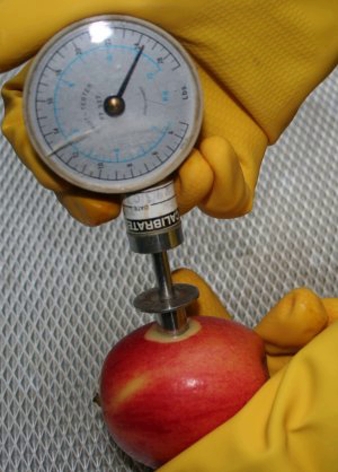
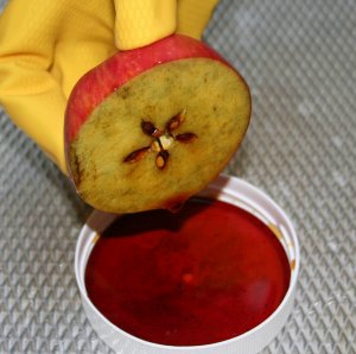
The higher the pressure reading the more confident we can be that apples coming out of store will meet customer specification.
To achieve a firmness of 6.5kg out of store in March the average fruit pressure must exceed 8.6kg.
Using a solution containing 1% iodine and 4% potassium iodine we measure the starch conversion rate by cutting each apple equatorially and dipping the cut face into the solution.
Levels of starch indicate the capability of the apple to store well. The minimum percentage of starch varies by variety. Cox needs t be above 70 percent starch at harvest, while other varieties vary.
Assessing Brix (sugar level) is also an important task as brix influences flavour and is a determining factor in fruit 'dry matter' however leaving apples on the tree for longer will not necessarily raise the brix level, but conversion of starch into sugars in store is part of the process.
Refractometers measure the brix level by squeezing apple juice onto the prism and reading through the eyepiece (like a telescope) or in the newer refractometers by squeezing into the small reservoir and reading the result.
Below: left; a standard refractometer and right; a modern refractometer
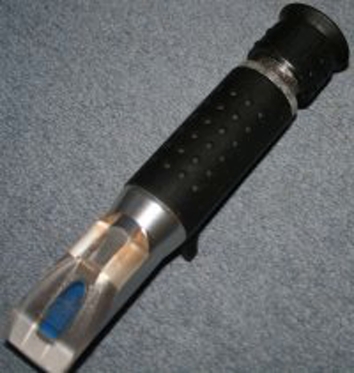
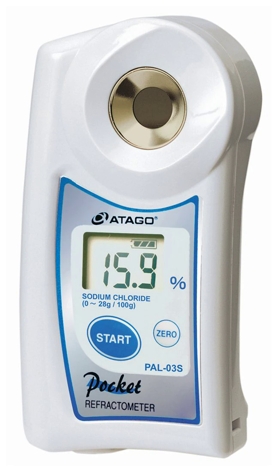
When light enters a liquid at an angle, it changes direction. This phenomenon is called refraction. Light will refract more when travelling through a liquid with dissolved or suspended solids. Therefore, refraction can be used to measure the concentration of dissolved or suspended solids within a solution.
So, critical factors in successful long term storage are 'fruit firmness & brix levels'
Below: today technologists use electronic penetrometers which deliver 'consistant instant results fed to a computer saving endless physical data entry.
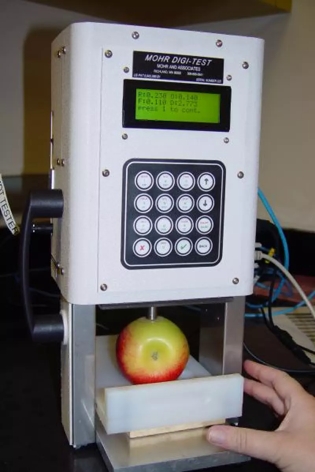 Monitoring apples in store
Monitoring apples in store
Technologists carry out monthly inspections on storage samples throughout the storage period checking fruit firmness and internal condition. The English Apple Man features his friend Jeremy Linsell at Braiseworth Orchards 'Instagram entry' showing Sharnee Butcher taking fruit/firmness readings.
In the video below, Sharnee Butcher from Worldwide Fruit tests apples in store for firmness
Click on Sharnee
![]() That is all for this week
That is all for this week
Take care
The English Apple Man